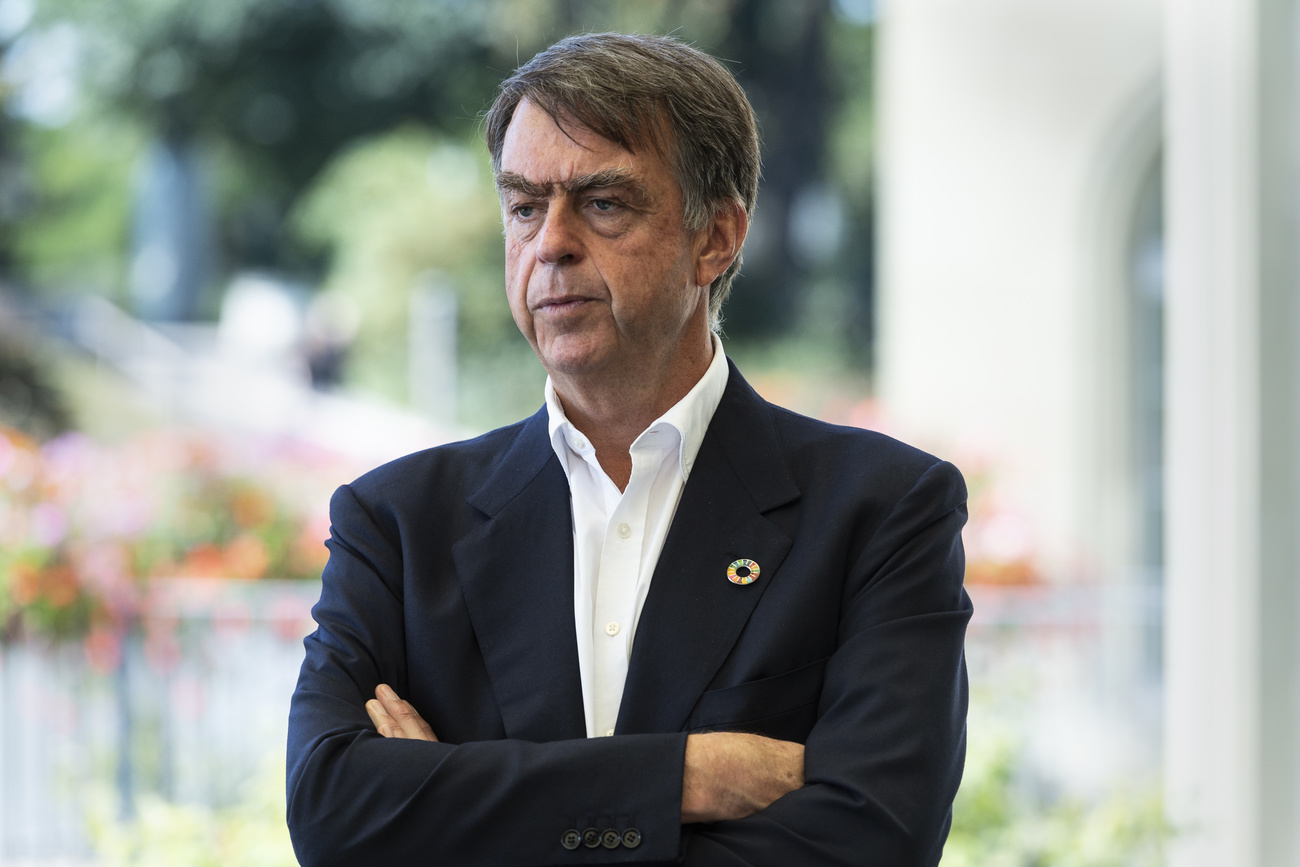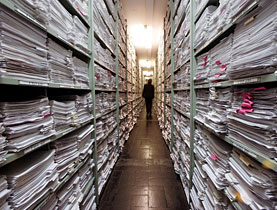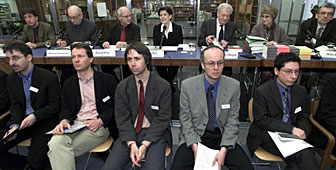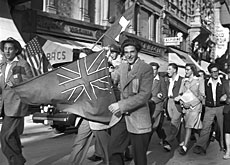Historian exposes secret wartime refugees

Some 500 Nazis, Italian fascists and supporters of the French Vichy regime found shelter in Switzerland at the end of the Second World War, says a Swiss historian.
swissinfo talked to Luc van Dongen who has opened the Pandora’s box of the 1943-1954 period, throwing light on Swiss asylum policy and uncovering the traces of numerous highly controversial political and economic refugees.
The university professor’s recently published book, “Un purgatoire très discret” (A very discreet purgatory), is based on ten years’ work going through archives in Bern, Berlin, London, Paris and Washington.
Among the more well-known figures he exposes in his book are Mussolini’s daughter, Edda Ciano, “Italian Goebbels” Dino Alfieri, Gestapo chief Rudolf Diels, SS officer Franz Sommer, as well as numerous Vichy regime ministers, industrialists, intellectuals, scientists and collaborators.
Until now much attention has focused on Switzerland’s fiercely controversial wartime actions in denying entry to refugees, and little is known about sensitive refugee cases who were officially – but secretly – let into the country.
swissinfo: Who were these highly controversial refugees who were given shelter in Switzerland?
Luc van Dongen: The Germans (100) were mostly economic refugees – specialists – as well as individuals who belonged to the SS and the Gestapo – but not the major players. Many fled Germany in 1944-46 when the Allies carried out automatic arrests.
For the Italians (100), the biggest group was made up of industrialists from northern Italy – Volpi, Cini, Benni, Marinotti – who were rich and influential with strong historical links to Swiss industry. There were also fascists who later turned against Mussolini in 1943, and important neo-fascists from repressive paramilitary organisations.
Among the French (300) are supporters of Marshal Pétain, Vichy officials, collaborators and militia members. There are women who had relations with the Germans, intellectuals and journalists. Three-quarters of the French refugees had problems with the political purge in France in 1945, which was very badly viewed by the Swiss authorities. It was not a problem for these people to come to Switzerland.
swissinfo: Were these refugees known to the Swiss public?
L. v. D.: No. The majority of refugees, 95 per cent, were unknown to the general public and the Swiss parliament.
Several examples came to light and the press became interested. But this was the fault of the people themselves as they were already well-known figures, like Mussolini’s daughter Edda Ciano, or certain Italian fascist aristocrats or industrialists or Vichy officials, and they had lively social lives.
The media wasn’t uninterested. There was public hostility towards that particular group of potential refugee cases and that’s why no one talked about them.
swissinfo: What was the official Swiss government position regarding these refugees?
L. v. D.: Up to 1948 requests by politically sensitive refugees were made to the public prosecutor’s office, either via foreign consulates, at the border or once they’d arrived secretly in Switzerland.
The foreigners’ police, the public prosecutor’s office and the cantons dealt with them on a case-by-case administrative basis.
The public prosecutor’s office was the most centralised body, but no lists were kept. The cantons and police chiefs knew about the cases under their charge but not those in other regions, so knowledge about them was very sketchy. In all, a maximum of 20 federal or cantonal civil servants knew about all 500 cases.
They tried to avoid publicity, as traditionally people didn’t talk about refugees in public so as to protect the families. That category of refugees was extremely sensitive, and publicity risked sparking controversy and pressures both at home and abroad.
When a case came to light owing to an accident, or someone was recognised by a journalist or member of the general public, normally they were quickly expelled.
swissinfo: To what extent did Switzerland actively attract certain “desirable” fascist refugees?
L. v. D.: It did take part in a so-called brain drain; this is something that was little known up to now.
The Swiss authorities became interested in this issue and once they saw that the Allies, particularly the Americans, were unscrupulous, from 1947-48 Swiss policy changed. But they were discreet and introduced measures so the Allies didn’t find out.
The Bergier report highlighted a few cases but what I showed is that it wasn’t a small affair. I identified around 100 specialists, technicians, engineers and scientists who came to Switzerland and worked for Brown Boveri, Bührle, Dubied and the federal institute of technology. And some of them are important figures.
swissinfo: What was the reaction of the Allies at the time? Did they put pressure on Switzerland?
L. v. D.: From 1943 the Allies called on neutral countries not to welcome war criminals and to be strict and tighten up controls on trains.
But there was another side to the political coin, especially with the Americans, which involved recuperating and benefitting from the interesting political or economic cases that came to Switzerland. They put pressure so certain people were expelled.
swissinfo: What happened to this category of refugees after the war?
L. v. D.: The general trend was a return to their home countries, which was not always voluntary. Then there were those who didn’t want to reintegrate back home – the more radical elements – who refused to return and continued on to Latin America.
And there is a small minority, around 50, who stayed in Switzerland for a few years. Most of the French stayed into the 1950s.
swissinfo-interview: Simon Bradley
The surrender of Nazi Germany ended six years of horror for Europe, and was a huge relief for neutral Switzerland. The country had spent the war trying to avoid antagonising the Nazis, and had lived in constant fear of invasion.
In the 1990s, uncomfortable revelations surfaced about Swiss banks handling assets looted by the Nazis and refusing to release details of dormant accounts held by Holocaust victims.
The scandals prompted the government to set up an independent commission of experts, led by Swiss historian Jean-François Bergier, to investigate Switzerland’s wartime past.
The final report, published in 2002, shattered many myths about the country’s wartime history. Bergier’s commission found that government and industry had cooperated with the Nazis, and that Switzerland had turned away thousands of Jewish refugees at its borders.
The report also destroyed the idea that Switzerland’s defences had saved it from Nazi invasion, and highlighted the uneasy relationship the Swiss had had with Germany.
In the five-year probe into Switzerland’s wartime past presented in 2002, the Independent Commission of Experts (ICE) condemned government policy towards the Nazis and the treatment of refugees.
Border guards turned away at least 24,000 refugees during the Second World War, most of them Jews. Yet Switzerland did provide sanctuary to some 300,000 people during the war years.

In compliance with the JTI standards
More: SWI swissinfo.ch certified by the Journalism Trust Initiative














You can find an overview of ongoing debates with our journalists here . Please join us!
If you want to start a conversation about a topic raised in this article or want to report factual errors, email us at english@swissinfo.ch.